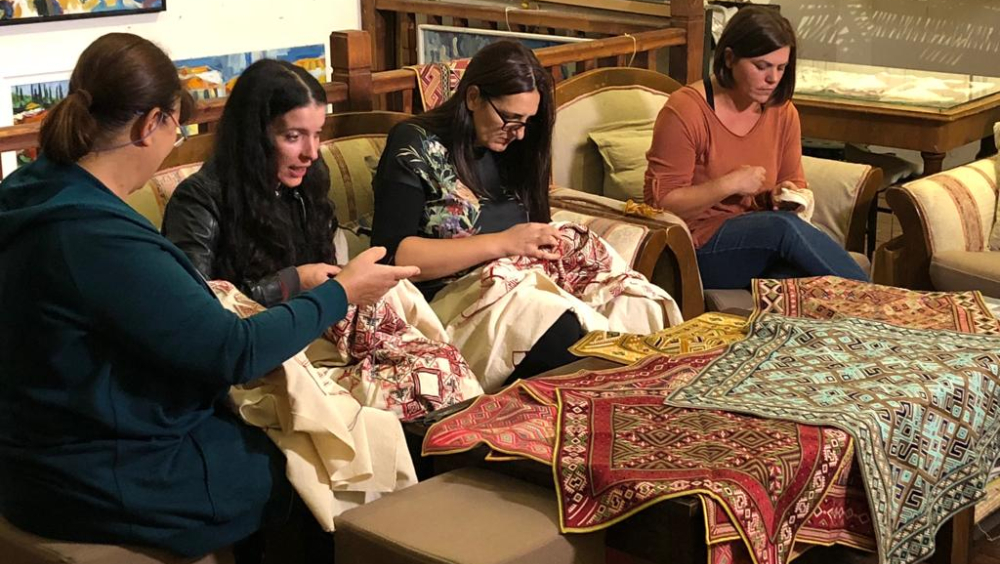Silk production and the art of making Konavle embroidery
Traditional silk production and art of making Konavle embroidery are well preserved ancient skills, still alive in region of Konavle, Dubrovnik hinterland. It is also a bridge that connects us with Medieval identities in as much connecting us with all other European ethnicums and their need of expressing information throughout textile skills. Throughout the Europe we trace leftovers of the huge cultural expression from preindustrial time. Nevertheless in Konavle region we have it mostly preserved. It's not only about clothing, it's not about being dressed, it's about identification throughout the language, identification throughout unverbal communication carried upon the art of stitching. This is a story about dowry. This is a story about pre marriage preparation. This is a story about women intangible.
Once upon a time Konavle embroidery was the only decoration on traditional women’s costume, today it is protected cultural heritage of the Republic of Croatia and probably the only thing that is solely autochthonous to the Konavle region. The way it was preserved through all these centuries can be understood only through understanding the core nature of life in Konavle. At the border of the worlds, at the border of the Gregorian and Julian calendar, at the border of the big empires, Ottoman and Venetian the Konavle region was tightly joined to the Dubrovnik Republic that abolished slavery in 1416. Precisely this stubbornness of differentiation from neighbours and the need to be part of the big world, in the sense of belonging to the Republic, the unique elements of this specific region were preserved. By marrying always from inside the region, in between the 30 villages women would stay inside the same cultural reality. Inasmuch all Dinaric elements from traditional women’s costume were reduced to a harmoniously compressed expression that, to this day captures everyone’s attention. But things could have been different. The embroidery could have been dispersed through every part of traditional dress and with time it could have completely disappeared. In reality all embroidered decorations that we would expect on a historic ruler’s dress was compressed into a tiny silk embroidered sleeves and embroidered chest pieces combined and worn upon the life situations. Major task for every girl in Konavle consisted of preparing her dowry before marriage, which included all her clothes for a lifetime, nothing else. This included clothes both for celebrating and mourning, sleeping and working. The difference between the occasions was made by the use of embroidery attached to costume. The burial gown was the same one worn on the wedding considering that before the God you have to have the most beautiful embroidery. The happiest women were those who managed to wear all of their embroidered pieces throughout the life. Heavy life circumstances of the 20th century, wars and crises were marked by numerous embroidery patterns that commemorate death in family or in village. Numerous beautiful multicolored embroideries were dyed black on the sad occasion of husband’s death. Widows thus sacrificed all of their “treasures” by drowning their colour and gleam in black to mourn their husbands. Nevertheless gleam from the homemade silk embroidery can’t be diminished while dyed with black colour because every girl in Konavle nourished their silkworms with love. For every girl in Konavle embroidery and silk production were the first initiation in essential womanhood. At the age of six they started their first embroidery patterns. They produced and dyed their own silk threads for all of their embroideries. Everything culminated with marriage. After marriage woman no longer produced silk or embroidery, they dedicated their lives to other jobs. As life went on in certain circumstances and conditions they would change their embroidered pieces, but the very first time they wore one in particular they would have marked it by applying silk tassels. Four or five tassels that made up the cross at the reverse side were the main protection for the silkworm seeds hidden behind the embroidery until they hatched. Those same tassels have put to sleep many babies tickling them while in arms of their mothers or grandmothers. Embroideries with tassels are full of love and everyone who grew up in Konavle knows that. In difficult times and unknown tomorrows they have remained anchors that tied Konavle to their distant past. As ode to power of every women in Konavle who have maintained this art of craftsmanship by respecting their teachers and refraining from individual expressions through embroidery, today we maintain the art of making Konavle embroidery and silk production as the most beautiful gifts of our women ancestors in Konavle.
Craftsmanship of the personal clothes decoration is common throughout the Europe. Probably the best way to diagnose specific identities in pan-European heritage.
